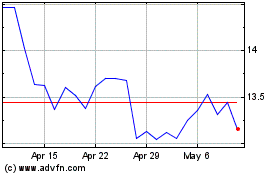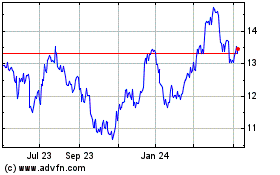By Jacob Bunge
On Midwestern fields and in research greenhouses, agricultural
giants like Monsanto Co. and BASF SA are teaching machines how to
farm.
The companies are expanding early-stage investments in
artificial intelligence, joining other industries in betting that
research and decision-making can be streamlined with computer
programs that teach themselves by picking patterns out of data.
Corn plants chosen with the help of computers are growing in the
U.S. this year, and algorithms are sifting North American weather
data to anticipate crop threats such as pests and disease.
BASF, the German chemical conglomerate, is working on automated
image- recognition capabilities similar to those that confirm faces
on Facebook and Apple's Photos app. The idea is to analyze farmers'
photographs of suspicious spots on crop leaves and deliver early
warnings for diseases such as wheat leaf rust, said Richard
Trethewey, who heads bioscience digitalization for BASF.
While some farmers are skeptical of the technology, others
figure it could evaluate crop development and identify disease as
well as or better than they can. Gunter Jochum, who grows canola,
soybeans and wheat near Winnipeg, Manitoba, watched firsthand the
learning curve of a computer program developed by BASF known as
Maglis.
In the spring of last year, Mr. Jochum told Maglis the date he
sowed canola, and his fields' coordinates. The program "pretty
accurately" guessed when the first seedlings would pop up, he said,
and by harvest time it had grown smarter as it predicted when crops
would be ready for harvest and how many bushels his land would
yield.
"In the beginning, I was a little bit leery," said Mr. Jochum.
"As the season went on, I was astonished how close it was." This
summer, he said, Maglis parsed weather and field data to foretell a
damaging plant fungus.
The companies, which spend billions of dollars annually to
research new seeds and farm chemicals, declined to specify how much
of that goes toward developing artificial intelligence.
Monsanto, the world's largest seed company, has been taking
computers' advice as it matches up corn strains to produce the
highest-yielding and sturdiest varieties.
Eight years ago, data scientists at the St. Louis company used
15 years' worth of information on corn varieties to build a
self-teaching algorithm. That has helped Monsanto researchers more
accurately predict how thousands of combinations of strains will
perform in their first year in the field.
Michael Graham, who heads Monsanto's plant-breeding operations,
said the system lets the company evaluate about five times more
corn varieties than it could in the past, and save a year of
research time. Over the past year, Monsanto has sold corn seeds
matched with the algorithm's input to U.S. farmers.
Self-learning software doesn't yet range freely across farm
fields. Mr. Graham said the technology's shortcomings showed up one
year when Goss's wilt, a disease that withers corn leaves, struck
further east in the U.S. corn belt than it had in the past,
catching Monsanto's corn-breeding model off guard. At BASF, the
Maglis machine learning functions remain under human supervision,
with crop specialists reviewing its analyses.
The field-by-field variation in weather, soil and pest
conditions poses steep challenges for artificial-intelligence
software, even with the data-collecting abilities of high-tech
machinery and soil sensors. And many critical data points -- such
as crop yield or the ultimate impact of a dry spell -- only emerge
once per year.
As the farm sector nurtures artificial intelligence's early
promise, it is looking for ways to fuse the technology with other
advances in agriculture. Tractor maker Deere & Co. agreed this
month to pay $305 million to buy Blue River Technology, a startup
developing tractor-towed robots that can analyze crops and apply
fertilizer and pesticides plant-by-plant. In the Netherlands,
Novozymes AS is developing microbe-based products that help crops
grow faster and fend off pests.
The company aims to use machine learning to identify promising
genetic patterns in microbes' DNA sequences. Some microbes chosen
with help from machine-learning technology are now being tested in
Novozymes' greenhouses, "where we see very clear improvement in the
[success] rate we are getting," said Ejner Bech Jensen, head of
bio-ag research at the company.
Mr. Trethewey, of BASF, said machine learning could revamp the
way the company studies chemical molecules' effects on fungus,
weeds and other pests. BASF is developing artificial intelligence
that can snap photos of test plants growing in petri dishes, using
visual-interpretation technology to track the effects of
herbicides. The technique frees lab workers from repetitive tasks
and avoids human error, he said.
BASF, which sold $5.9 billion worth of pesticides and other
agricultural products last year, is powering its push into
artificial intelligence with a new supercomputer named Quriosity,
now being installed at the company's headquarters in Ludwigshafen,
Germany.
While agricultural giants explore machine learning, many farmers
don't expect to abandon traditional methods anytime soon.
Dale Huss, who oversees artichoke production for
California-based Ocean Mist Farms, said that any technology that
can help farming is worth considering. "But the day's not going to
come when something tells me what seed to plant, how much to water,
or what type of fertilizer to use, " he said.
Mr. Jochum, the farmer near Winnipeg, sees room on his farm for
artificial intelligence and may even pay for the advice that Maglis
provides. Still, "nothing really beats the human touch right in the
field," Mr. Jochum said. "And a machine is only as good as the
information you input into it."
Write to Jacob Bunge at jacob.bunge@wsj.com
(END) Dow Jones Newswires
September 13, 2017 07:14 ET (11:14 GMT)
Copyright (c) 2017 Dow Jones & Company, Inc.
BASF (QX) (USOTC:BASFY)
Historical Stock Chart
From Dec 2024 to Jan 2025

BASF (QX) (USOTC:BASFY)
Historical Stock Chart
From Jan 2024 to Jan 2025
